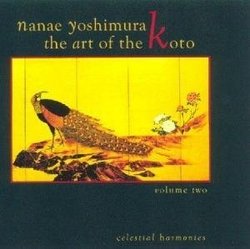Heir to the Reigning King of all Koto CDs
Crazy Fox | Chicago, IL USA | 05/30/2006
(5 out of 5 stars)
"Well, lightning does strike twice. Like its predecessor, this is a truly excellent CD of koto music, and I'd give it six stars if I could. Once again, the sound quality is crystal clear, the performances inspired and superb, and the music itself very beautiful--refined and elegant and yet energetic and alive.
In terms of selection, the first two tracks are classic compositions by Yatsuhashi Kengyo in the 1600's, as with Volume One. This time "Hachidan" is included, forming a set with "Rokudan" and "Midare" on the first volume; then "Shiki no Kyoku", a difficult composition rarely performed nowadays. Then we shift gears and in terms of koto history start where volume one left off, first with a piece by Matsuzaka Harue in the late 1800's and then with three masterpieces by Miyagi Michio in the early twentieth century.
Again as with volume one, the liner notes for this album are incredibly extensive and professional. It's wonderfully clear that much effort went into them, and one gets a real crash course in koto music from reading it--people new to the koto will learn all that's necessary for them to have a pretty good idea what's going on, and people who've loved koto music for ages will yet learn something new (I sure did, anyway). First we get a good description of the instrument and its history, picking up where volume one left off. Next each track is introduced and explained in fine, loving detail. Once again, happily, the lyrics to the vocals on tracks one, three, and four are given: first in the original Japanese (transcribed in romanji), then in a literal word-for-word translation, and then afterwards in a smooth idiomatic English rendition. Such a practice is quite a rarity among CDs in this field, so this extra effort and care is remarkable. And musicological details for the music expert are included, too--arcane to an amateur like me, but useful to those with the requisite knowledge, I have no doubt. Finally, each performer is introduced along with a quick summary of her or his career.
In short, this is an excellent CD on all counts. As an album it stands on its own quite well, but listening to it after volume one will increase one's appreciation, too. And both the newly koto-curious and the long-time koto-connoisseur will find something to love about it. Highly recommended."
Glad I got this
P. de Freitas | 05/26/2007
(5 out of 5 stars)
"I was looking for something new, which I didn't at all know. Something to tickle the back of my head out of its complacency. After reading the reviews of Crazy Fox, this was one of the things I got. I did feel apprehensive about trusting a single voice to be at all accurate, since tastes differ greatly, but I wasn't at all disappointed.
The music remains of consistent quality throughout, sometimes fast paced, sometimes stately, but never unsettling. As such I find it excellent to relax and unwind with.
The booklet explains a fair deal about what is presented, in English which doesn't bear any signs of being written by a first-year student of ESL. It doesn't just name titles, but it also places the music in its proper context and renders a translation of what is sung. Every effort has been made to make this accessible to someone who doesn't speak a single word of Japanese.
The music is very different from European style classical music, and as such takes a bit of effort to wrap one's head around. Once you figure out where the beat is (and it shifts a LOT more than you'd be used to) you start to realize the depth of expression that's being put forth.
The vocals are in a very different style, too, and might take some getting used to if you hear this sort of music for the first time. This is a trip to someone else's beaten track, though, so once you know what to expect of it, it fits in perfectly.
All in all, I feel that if you're looking for something different, finding this will be rewarding. It certainly was for me.
"


 Track Listings (6) - Disc #1
Track Listings (6) - Disc #1